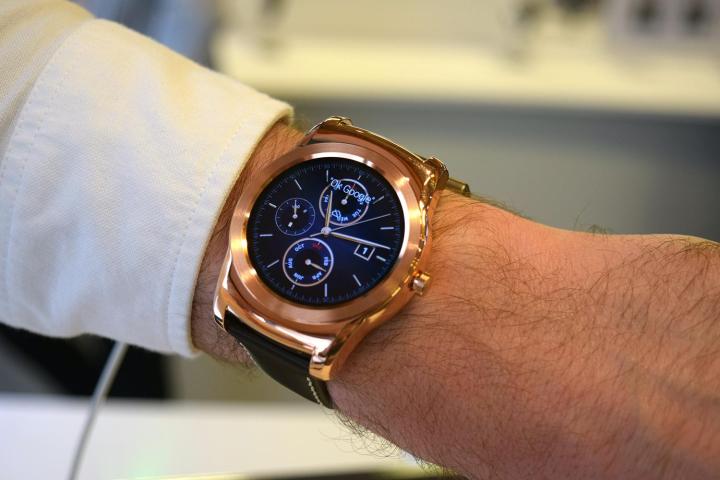
Updated on 06-19-2015 by Kyle Wiggers: Changed the article’s language to reflect Android Wear 5.1.1’s availability on the Moto 360 and other Android Wear smartwatches.
Google’s calling the update the “biggest yet” for Android Wear, and it’s easy to see why. True to early rumors, the update is packed to the brim with enhancements and improvements, the smallest (but potentially most convenient) of which is a new motion gesture for navigating through notifications. Flicking your wrist towards you will move to the next onscreen card in the queue, while twisting away will display the previous one. That may sound precariously easy to trigger, but lead product manager for Wear Jeff Chang told the Verge that much work has been done to reduce false positives. If you’re an overzealous gesticulator, though, you can toggle the gesture off in settings.
Second in tow is a surprise addition: emoji doodling. It comes on the heels of Handwriting Input for Android’s release, and is intended those all-too-common scenarios when talking to your wristwatch isn’t quite appropriate (is it ever?). You can reply to messages by drawing approximations of emoji which Wear will do its best to transcribe, but in case your hurried, surreptitious handwriting doesn’t yield anything, there’s a pull-up list of the top 25 most popular emoji. Not to worry if you’re a traditionalist and would rather stick with the canned text responses that shipped with

Separately, the update is making ambient mode — the monochromatic power-saving screen on Android Wear that appears in lieu of sleep — a whole lot more useful (or at least not as useless). It’s now open to development — should you choose to enable ambient mode following the update, apps that take advantage will show static information (i.e., a shopping list, map, or music controls) when your smartwatch’s screen fades. Of course, ambient mode is still only really suited to AMOLED devices because it lights up the entire display on the device with traditional panels, reducing battery. Still, the convenience might be reason enough to justify the power draw.
Two last features round things out. The first, an updated app selection screen, addresses a longstanding problem on Android Wear: It’s way harder than it should be. Right now, it requires either swiping up to the watch face, tapping the watch, and selecting “Start…” at the very bottom of a needlessly long list of commands, or saying “OK Google” and the app’s name (if you can remember it). The update removes a few of those abstraction layers — bringing up the list of apps now only takes a swipe to the left of the watch face. Swiping left again shows contacts. Commands, thankfully, have been relegated to a third and final tab.
The update contains the rumbled-about Wi-Fi support, but with a few twists. Wi-Fi lets you perform many of the functions with which you’re familiar — accepting or rejecting phone calls, searching with voice, and receiving notifications — but not just on the network to which your phone is also connected. Thanks to Google’s servers, you’ll sync to your phone on any hotspot, no local tether required. Plus, your watch will actively seek open connections while you’re out and about, minimizing the chance you miss a reminder because of Bluetooth interference. Wi-Fi comes with a major catch, though: While many of the most popular Android Wear devices contain the requisite hardware, OEMs will ultimately decide which models to support.
One feature the update won’t contain is support for Apple devices. Google’s reportedly working to get Android Wear devices to function with iPhones — A while ago, a source close to the matter said the company was close to “finishing the final technical details” of a companion app for iOS. It obviously stands a lot to gain from such an integration, but Google has the undesirable task of fighting the preeminent Apple Watch for sales and mindshare. Tellingly, sales of the Apple Watch have already surpassed the lifetime sales of all
Still, the update is a step in the right direction. While Android Wear devices can undoubtedly count value in their favor — the average price for a smartwatch hovers around $250, while the cheapest Apple Watch is $350 — they haven’t quite achieved feature parity with Apple’s offering. Notably missing is support for payments, NFC and otherwise. It’s a waiting game, at this point — Google’s big developer conference came and went without a substantive update on the company’s plans for
Editors' Recommendations
- Google just announced 8 big Android updates. Here’s what’s new
- Your Android phone is getting lots of fun new features this month
- Wearing the Galaxy Watch 5 showed me just how basic the Pixel Watch really is
- Does the Google Pixel Watch have fall detection? Not yet, but it’s coming soon
- Is the Google Pixel Watch waterproof? Read this before getting it wet




